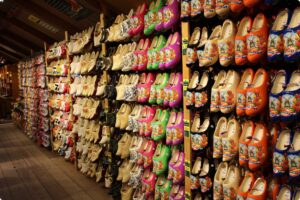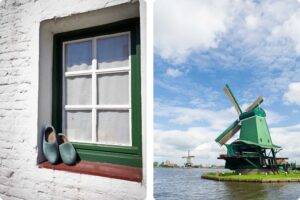The Netherlands (Zaanse Schans) is known for its clogs and is not only a symbol of the country, but also important in the history of craftsmanship. The Zaanse Schans plays a role in keeping this tradition alive. In this blog, I will tell you more about the history of wooden shoes and what the Zaanse Schans has to do with it.
Origin of clogs
Clogs come from the Middle Ages. The first clogs come from the year 1200 and were probably inspired by wooden soles and leather sandals that were popular at that time. The oldest wooden shoe ever found was found in Amsterdam and is more than 800 years old.
Why were clogs so popular? Clogs were cheap to make and were sturdy which was important for heavy work in the fields or workshops. The wooden sole under the clog provided protection from sharp objects, mud and humidity. This made clogs popular for fishermen, farmers and workers.
Wooden shoes as craftsmanship
Clogs were not just shoes. They were often decorated with paintings or carvings that revealed the origin or profession of the wearer. In some places in the Netherlands, clogs were decorated with special detailed patterns and were part of festive dress. Craftsmanship was an important aspect of clog-making and this process was often passed down from generation to generation.
For centuries, clog makers used simple tools such as knives and axes, so they could make the clogs completely by hand. By the 19th century, machines were developed to make this process faster. The traditional craft persisted, especially in places like the Zaanse Schans.
The Zaanse Schans: clog capital
Zaanse Schans is a village in North Holland which has become an open-air museum. This is one of the few places in the Netherlands where the art of clog-making is still practised. Visitors here can see how wooden shoes used to be made, both by hand and with machines. Demonstrations of this show the skills of the clog makers.
Zaanse Schans has a long history with clogs, as this region used to be known for its artisans. Clog makers were as important here as other craftsmen and millers. Zaanse Schans offers a beautiful setting to experience the lifestyle and traditions of Dutch history.
Clogs in today’s time
Although clogs are not worn daily by most Dutch people these days, they remain a tradition of Dutch culture. Often in hospitals, wearing clogs is often done by nurses. Furthermore, in the Zaanse Schans, wearing clogs is still done by farmers and artisans. This is not just for show, but the clogs are practical for the work these people do.
In addition, the clogs in the Zaanse Schans are an important tourist product. The wooden clogs are often colourfully painted and sold worldwide as souvenirs.
The Zaanse Schans offers a unique opportunity to see the history of craftsmanship in the Netherlands. Are you curious to find out more fun facts about Dutch culture and the Zaanse Schans? Look at the blog with the most fun things to do at the Zaanse Schans! You can also do the SmartWalk Zaanse Schans and learn all the hidden gems about this city while you are walking a self-guided tour!







